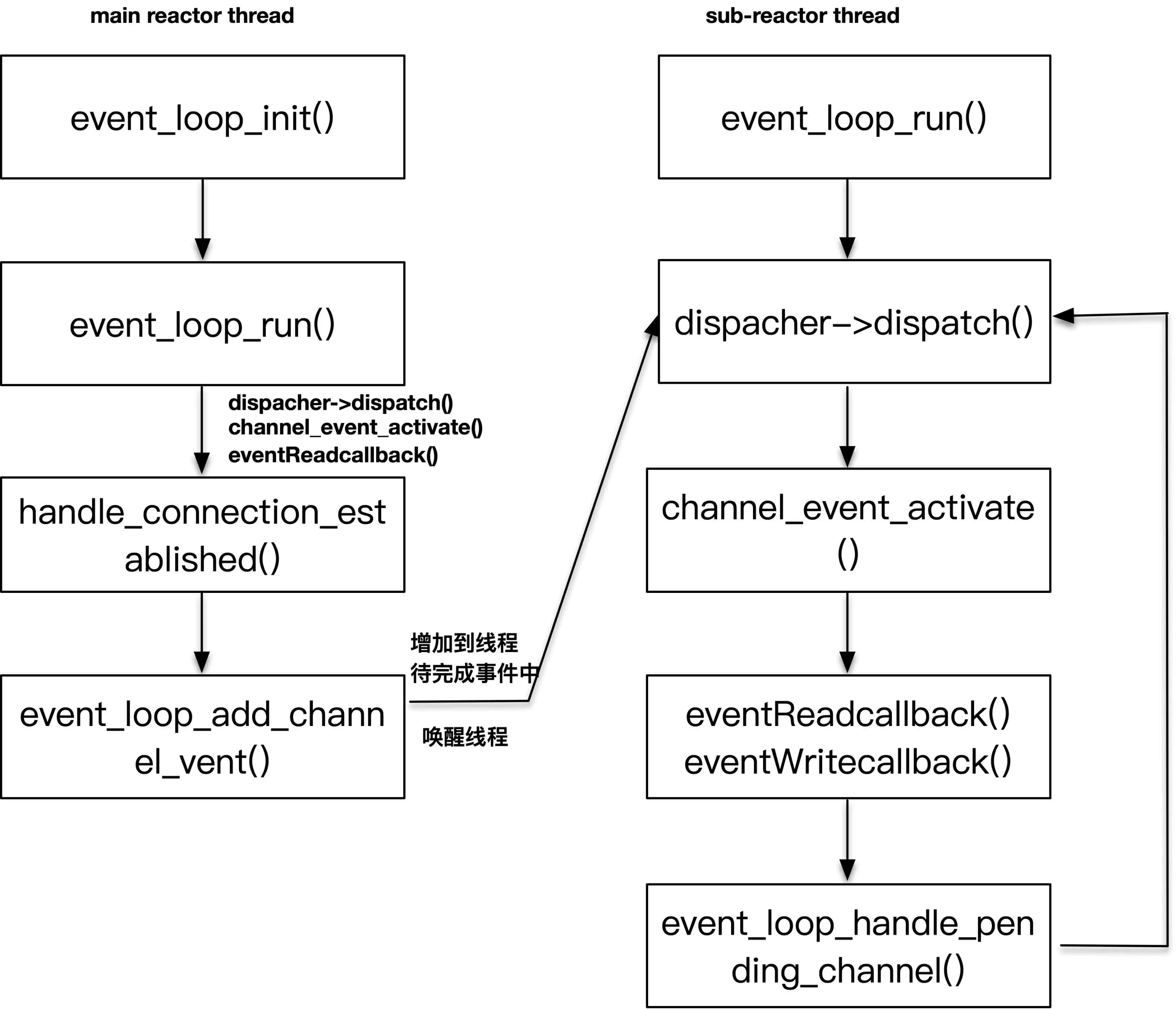多线程设计的几个考虑
在反应堆reactor框架设计中,main reactor线程是一个acceptor线程,这个线程一旦创建,会以event_loop形式阻塞在event_dispatcher的dispatch方法上,实际上它是在等待监听套接字上的事件发生,即已完成的连接,一旦有连接完成,就会创建出连接对象tcp_connection,以及channel对象等。
当用户期望使用多个sub-reactor子线程时,主线程会创建多个子线程,每个子线程在创建之后,按照主线程指定的启动函数立即运行,并进行初始化。随之而来的问题是,主线程如何判断子线程已经初始化并启动,继续执行下去呢?这是一个需要解决的重点问题。
在设置了多个线程的情况下,需要将创建的已连接套接字对应的读写事件交给一个sub-reactor线程处理。所以,这里从thread_pool中取出一个线程,通知这个线程有新的事件加入。而这个线程很有可能是处于事件分发的阻塞调用之中,如何协调主线程数据写入给子线程,这是另一个需要解决的重点问题。
子线程是一个event_loop线程,它阻塞在dispatch上,一旦有事件发生,他就会查找channel_map,找到对应的处理函数并执行它,之后它就会增加、删除或修改pending事件,再次进入下一轮的dispatch。
下图阐述了线程的运行关系:

对应的函数如下图:

主线程等待多个sub-reactor子线程初始化完,也就是需要获取子线程对应数据的反馈,而子线程初始化也是对这部分数据进行初始化,实际上这是一个多线程的通知问题。采用的方法主要武器就是mutex和condition。
下面代码是主线程发起的子线程创建,调用event_loop_thread_init对每个子线程初始化,之后调用event_loop_thread_start来启动子线程。注意,如果应用程序指定的线程池大小为0,则直接返回,这样acceptor和I/O事件都会在同一个线程里处理,就退化为单reactor模式。
//一定是main thread发起
void thread_pool_start(struct thread_pool *threadPool) {
assert(!threadPool->started);
assertInSameThread(threadPool->mainLoop);
threadPool->started = 1;
void *tmp;
if (threadPool->thread_number <= 0) {
return;
}
threadPool->eventLoopThreads = malloc(threadPool->thread_number * sizeof(struct event_loop_thread));
for (int i = 0; i < threadPool->thread_number; ++i) {
event_loop_thread_init(&threadPool->eventLoopThreads[i], i);
event_loop_thread_start(&threadPool->eventLoopThreads[i]);
}
}
event_loop_thread_start这个方法一定是主线程运行的,这里使用pthread_create创建了子线程,子线程一旦创建,立即执行event_loop_thread_run(进行了子线程的初始化工作),这个函数最重要的部分是使用pthread_mutex_lock和pthread_mutex_unlock进行了加锁和解锁,并使用pthread_cond_wait来守候eventLoopThread中的eventLoop的变量。
//由主线程调用,初始化一个子线程,并且让子线程开始运行event_loop
struct event_loop *event_loop_thread_start(struct event_loop_thread *eventLoopThread) {
pthread_create(&eventLoopThread->thread_tid, NULL, &event_loop_thread_run, eventLoopThread);
assert(pthread_mutex_lock(&eventLoopThread->mutex) == 0);
while (eventLoopThread->eventLoop == NULL) {
assert(pthread_cond_wait(&eventLoopThread->cond, &eventLoopThread->mutex) == 0);
}
assert(pthread_mutex_unlock(&eventLoopThread->mutex) == 0);
yolanda_msgx("event loop thread started, %s", eventLoopThread->thread_name);
return eventLoopThread->eventLoop;
}
为什么这么做呢?子线程执行函数event_loop_thread_run一上来也是进行了加锁,之后初始化event_loop对象,当初始化完成之后,调用了pthread_cond_signal函数
来通知此时阻塞在pthread_cond_wait上的主线程,这样,主线程就会从wait中苏醒,代码得以往下执行。子线程本身也通过调用event_loop_run进入了一个无限循环的事件分发执行体中,等待子线程reactor上注册过的事件发生。
void *event_loop_thread_run(void *arg) {
struct event_loop_thread *eventLoopThread = (struct event_loop_thread *) arg;
pthread_mutex_lock(&eventLoopThread->mutex);
// 初始化化event loop,之后通知主线程
eventLoopThread->eventLoop = event_loop_init();
yolanda_msgx("event loop thread init and signal, %s", eventLoopThread->thread_name);
pthread_cond_signal(&eventLoopThread->cond);
pthread_mutex_unlock(&eventLoopThread->mutex);
//子线程event loop run
eventLoopThread->eventLoop->thread_name = eventLoopThread->thread_name;
event_loop_run(eventLoopThread->eventLoop);
}
可看到,这里主线程和子线程共享的变量正是每个event_loop_thread的eventLoop对象,这个对象在初始化的时候为NULL,只有当子线程完成了初始化,才变成一个非NULL的值,这变化是子线程完成初始化的标志,也是信号量守护的变量。通过使用锁和信号量,解决了主线程和子线程同步的问题。当子线程完成初始化之后,主线程才会继续往下执行。
struct event_loop_thread {
struct event_loop *eventLoop;
pthread_t thread_tid; /* thread ID */
pthread_mutex_t mutex;
pthread_cond_t cond;
char * thread_name;
long thread_count; /* # connections handled */
};
主线程是循环在等待每个子线程完成初始化,如果进入第二个循环,等待第二个子线程完成初始化,而此时第二个子线程已经初始化完成了,该怎么办?
注意我们这里一上来是加锁的,只要取得了这把锁,同时发现 event_loop_thread 的 eventLoop 对象已经变成非 NULL 值,可以肯定第二个线程已经初始化,就直接释放锁往下执行了。
可能还会问,在执行 pthread_cond_wait 的时候,需要持有那把锁么?这里,父线程在调用 pthread_cond_wait 函数之后,会立即进入睡眠,并释放持有的那把互斥锁。而当父线程再从 pthread_cond_wait 返回时(这是子线程通过 pthread_cond_signal 通知达成的),该线程再次持有那把锁。
增加已连接套接字事件到sub-reactor线程中
主线程是一个 main reactor 线程,这个线程负责检测监听套接字上的事件,当有事件发生时,也就是一个连接已完成建立,如果我们有多个 sub-reactor 子线程,我们期望的结果是,把这个已连接套接字相关的 I/O 事件交给 sub-reactor 子线程负责检测。这样的好处是,main reactor 只负责连接套接字的建立,可以一直维持在一个非常高的处理效率,在多核的情况下,多个 sub-reactor 可以很好地利用上多核处理的优势。
这存在一个问题:sub-reactor 线程是一个无限循环的 event loop 执行体,在没有已注册事件发生的情况下,这个线程阻塞在 event_dispatcher 的 dispatch 上。sub-reactor 线程是一个无限循环的 event loop 执行体,在没有已注册事件发生的情况下,这个线程阻塞在 event_dispatcher 的 dispatch 上。
当然有办法。如果我们能让 sub-reactor 线程从 event_dispatcher 的 dispatch 上返回,再让 sub-reactor 线程返回之后能够把新的已连接套接字事件注册上,这件事情就算完成了。
如何让sub-reactor线程从event_dispatcher的dispatch上返回呢??
答案是构建一个类似管道一样的描述字,让event_dispatcher祖册该管道描述字,当我们想让sub-reactor线程苏醒时,往管道上发送一个字符就可以。
在 event_loop_init 函数里,调用了 socketpair 函数创建了套接字对,这个套接字对的作用就是我刚刚说过的,往这个套接字的一端写时,另外一端就可以感知到读的事件。其实,这里也可以直接使用 UNIX 上的 pipe 管道,作用是一样的。
struct event_loop *event_loop_init() {
...
//add the socketfd to event 这里创建的是套接字对,目的是为了唤醒子线程
eventLoop->owner_thread_id = pthread_self();
if (socketpair(AF_UNIX, SOCK_STREAM, 0, eventLoop->socketPair) < 0) {
LOG_ERR("socketpair set fialed");
}
eventLoop->is_handle_pending = 0;
eventLoop->pending_head = NULL;
eventLoop->pending_tail = NULL;
eventLoop->thread_name = "main thread";
struct channel *channel = channel_new(eventLoop->socketPair[1], EVENT_READ, handleWakeup, NULL, eventLoop);
event_loop_add_channel_event(eventLoop, eventLoop->socketPair[1], channel);
return eventLoop;
}
其中:
struct channel *channel = channel_new(eventLoop->socketPair[1], EVENT_READ, handleWakeup, NULL, eventLoop);
这告诉event_loop,是注册了socketPair[1]描述字上的READ事件,如果有READ事件发生,就调用handleWakeup函数来完成事件处理。
再来看下handleWakeup函数:
这个函数就是简单的从socketPai[1]描述字上读取了一个字符,主要作用就是让子线程从dispatch的阻塞中苏醒。
int handleWakeup(void * data) {
struct event_loop *eventLoop = (struct event_loop *) data;
char one;
ssize_t n = read(eventLoop->socketPair[1], &one, sizeof one);
if (n != sizeof one) {
LOG_ERR("handleWakeup failed");
}
yolanda_msgx("wakeup, %s", eventLoop->thread_name);
}
再回过头看看,如果有新的连接产生,主线程是怎么操作的?
在 handle_connection_established 中,通过 accept 调用获取了已连接套接字,将其设置为非阻塞套接字(切记),接下来调用 thread_pool_get_loop 获取一个 event_loop。thread_pool_get_loop 的逻辑非常简单,从 thread_pool 线程池中按照顺序挑选出一个线程来服务。接下来是创建了 tcp_connection 对象。
//处理连接已建立的回调函数
int handle_connection_established(void *data) {
struct TCPserver *tcpServer = (struct TCPserver *) data;
struct acceptor *acceptor = tcpServer->acceptor;
int listenfd = acceptor->listen_fd;
struct sockaddr_in client_addr;
socklen_t client_len = sizeof(client_addr);
//获取这个已建立的套集字,设置为非阻塞套集字
int connected_fd = accept(listenfd, (struct sockaddr *) &client_addr, &client_len);
make_nonblocking(connected_fd);
yolanda_msgx("new connection established, socket == %d", connected_fd);
//从线程池里选择一个eventloop来服务这个新的连接套接字
struct event_loop *eventLoop = thread_pool_get_loop(tcpServer->threadPool);
// 为这个新建立套接字创建一个tcp_connection对象,并把应用程序的callback函数设置给这个tcp_connection对象
struct tcp_connection *tcpConnection = tcp_connection_new(connected_fd, eventLoop,tcpServer->connectionCompletedCallBack,tcpServer->connectionClosedCallBack,tcpServer->messageCallBack,tcpServer->writeCompletedCallBack);
//callback内部使用
if (tcpServer->data != NULL) {
tcpConnection->data = tcpServer->data;
}
return 0;
}
在调用 tcp_connection_new 创建 tcp_connection 对象的代码里,可以看到先是创建了一个 channel 对象,并注册了 READ 事件,之后调用 event_loop_add_channel_event 方法往子线程中增加 channel 对象。
tcp_connection_new(int connected_fd, struct event_loop *eventLoop,
connection_completed_call_back connectionCompletedCallBack,
connection_closed_call_back connectionClosedCallBack,
message_call_back messageCallBack, write_completed_call_back writeCompletedCallBack) {
...
//为新的连接对象创建可读事件
struct channel *channel1 = channel_new(connected_fd, EVENT_READ, handle_read, handle_write, tcpConnection);
tcpConnection->channel = channel1;
//完成对connectionCompleted的函数回调
if (tcpConnection->connectionCompletedCallBack != NULL) {
tcpConnection->connectionCompletedCallBack(tcpConnection);
}
//把该套集字对应的channel对象注册到event_loop事件分发器上
event_loop_add_channel_event(tcpConnection->eventLoop, connected_fd, tcpConnection->channel);
return tcpConnection;
}
到现在为止的操作都是在主线程里执行。接下来就是加解锁。。。。
如果能够获取锁,主线程就会调用 event_loop_channel_buffer_nolock 往子线程的数据中增加需要处理的 channel event 对象。所有增加的 channel 对象以列表的形式维护在子线程的数据结构中。
接下来的部分是重点,如果当前增加 channel event 的不是当前 event loop 线程自己,就会调用 event_loop_wakeup 函数把 event_loop 子线程唤醒。唤醒的方法很简单,就是往刚刚的 socketPair[0]上写一个字节,别忘了,event_loop 已经注册了 socketPair[1]的可读事件。如果当前增加 channel event 的是当前 event loop 线程自己,则直接调用 event_loop_handle_pending_channel 处理新增加的 channel event 事件列表。
int event_loop_do_channel_event(struct event_loop *eventLoop, int fd, struct channel *channel1, int type) {
//get the lock
pthread_mutex_lock(&eventLoop->mutex);
assert(eventLoop->is_handle_pending == 0);
//往该线程的channel列表里增加新的channel
event_loop_channel_buffer_nolock(eventLoop, fd, channel1, type);
//release the lock
pthread_mutex_unlock(&eventLoop->mutex);
//如果是主线程发起操作,则调用event_loop_wakeup唤醒子线程
if (!isInSameThread(eventLoop)) {
event_loop_wakeup(eventLoop);
} else {
//如果是子线程自己,则直接可以操作
event_loop_handle_pending_channel(eventLoop);
}
return 0;
}
如果是 event_loop 被唤醒之后,接下来也会执行 event_loop_handle_pending_channel 函数。你可以看到在循环体内从 dispatch 退出之后,也调用了 event_loop_handle_pending_channel 函数。
int event_loop_run(struct event_loop *eventLoop) {
assert(eventLoop != NULL);
struct event_dispatcher *dispatcher = eventLoop->eventDispatcher;
if (eventLoop->owner_thread_id != pthread_self()) {
exit(1);
}
yolanda_msgx("event loop run, %s", eventLoop->thread_name);
struct timeval timeval;
timeval.tv_sec = 1;
while (!eventLoop->quit) {
//block here to wait I/O event, and get active channels
dispatcher->dispatch(eventLoop, &timeval);
//这里处理pending channel,如果是子线程被唤醒,这个部分也会立即执行到
event_loop_handle_pending_channel(eventLoop);
}
yolanda_msgx("event loop end, %s", eventLoop->thread_name);
return 0;
}
event_loop_handle_pending_channel 函数的作用是遍历当前 event loop 里 pending 的 channel event 列表,将它们和 event_dispatcher 关联起来,从而修改感兴趣的事件集合。
这里有一个点值得注意,因为 event loop 线程得到活动事件之后,会回调事件处理函数,这样像 onMessage 等应用程序代码也会在 event loop 线程执行,如果这里的业务逻辑过于复杂,就会导致 event_loop_handle_pending_channel 执行的时间偏后,从而影响 I/O 的检测。所以,将 I/O 线程和业务逻辑线程隔离,让 I/O 线程只负责处理 I/O 交互,让业务线程处理业务,是一个比较常见的做法。
小结
重点讲解了框架中涉及多线程的两个重要问题,第一是主线程如何等待多个子线程完成初始化,第二是如何通知处于事件分发中的子线程有新的事件加入、删除、修改。第一个问题通过使用锁和信号量加以解决;第二个问题通过使用 socketpair,并将 sockerpair 作为 channel 注册到 event loop 中来解决。